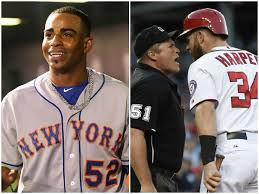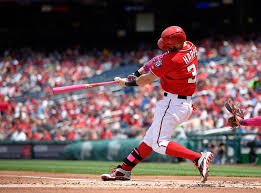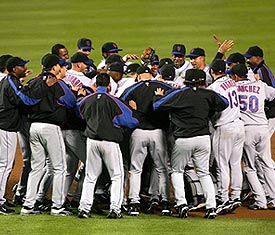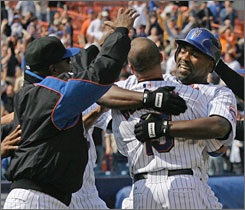
The 2015 Mets: Do Not Look Back
Keep your heads high, New York Mets fans. This team was special in more ways than one, from keeping themselves alive with an anemic offense for the first half of the year to storming past the rest of the National League in October, this was a dream season in reality.
The World Series was a bit of a debacle, but New York can take solace in the fact that if they played their best baseball, they easily would’ve won it all. It was just the wrong combination of slow offense and untimely errors that led to the team’s demise, if you can even call it that. The Mets blew past 28 other teams, but couldn’t close against the 29th.

In what became the pinnacle of the Mets season, they defeated the Dodgers in a 5-game NLDS, then swept Chicago Cubs in the NLCS (Getty Images).
Now the team will look ahead to what will be one of the most interesting offseasons in recent memory. They will look to wash the taste of a bad finish out their mouth, like they have tried to do for the last decade, but they’ll do so as real contenders and probably the favorites to repeat as National League Champions. The Wilpons and General Manager Sandy Alderson will be in a position unique to the franchise, where they’re already a very good team, but they need to replace or re-sign some key players to stay as competitive as they were this year.
The nucleus of the team under contract can probably get them back to the playoffs again next year. The starting pitching will return, as will most of the lineup, but two significant pieces could be missing come April. Yoenis Cepsedes and Daniel Murphy are free agents that got them to October and kept them in the postseason. Cespedes hit .291 with 35 homers in the regular season, for sure a career year for a talented player. Murphy hit seven homers in the first two round of the playoffs, one off the record for the most dingers in the playoffs ever.
The two were key pieces in 2015, but neither of them should be re-signed. Cespedes was the ultimate streaky hitter for the Mets. He was cold for the first part of August, went on a torrid hot streak to urge the Mets past the Nationals in the NL East, then cooled down towards the end of the year. He hit just .222 in the postseason, including .150 in the World Series. The Mets do not need an extreme Lucas Duda (who is another notorious consistently inconsistent hitter) in the middle of their lineup. Reports have already surfaced that the team won’t try their hardest to bring him back, and for good reason.

Daniel Murphy played above his normal value for most of the playoffs. Mandatory Credit: Caylor Arnold-USA TODAY Sports
Anyone who watched the Mets play in the regular season knows that the playoff version of Daniel Murphy is definitely not the same one you’ll get from April to September. Even he cooled off in the World Series, showing that the pressure of the biggest stage in baseball can affect the hottest of hitters. His defense is also a liability at best, and nonexistent at the worst. With the incredible pitching corps that the Mets have, they need a better defender than Murphy, whose errors were direct causes of multiple World Series losses.
Then the question is; who should they sign? It would be a uniquely ironic situation if the Mets were able to sign pending free agent Ben Zobrist, who just beat them as a member of the Royals. He is the prototype of what the Mets need at the second base position: he hits well, plays good defense, and can be moved around the infield in case someone in the infield (David Wright) isn’t 100 percent healthy. He won’t be the power bat, averaging 17 homers a season, but he’ll be the perfect fit in the second spot of the lineup, where Wright has been miscast all year.
What about Cespedes’ spot? It’s very possible that the Mets don’t sign an outfield bat, with the trio of Juan Lagares, Michael Conforto, and Curtis Granderson playing well. However, Lagares played with an injured arm for most of the year, and making a big signing will take the pressure to play off of him. If they do sign a free agent, they’ll probably go with someone that can play centerfield or right field, giving them the option to move Curtis Granderson around.

Mets fans are appreciative of what Yoenis Cespedes did for the team, but in all likelihood he will not be back come March. (Photo: Getty Images)
If they sign an outfielder, it will be someone with power to give them a middle-of-the-order presence not named Duda or d’Arnaud. That’s why Justin Upton is a viable option, albeit one with a high price. He hit .251 with 26 homers while playing in the worst offensive ballpark in the major leagues. He’s shown flashes of raw hitting potential and many think he’s on the verge of a breakout year if he’s given the opportunity to be the guy.
There are numerous possibilities, but the biggest realization is that the team can NOT go back to the way they were just a few months ago. Every player who’s coming back next year now knows what it feels like to have the greatest prize in the sport taken away from them. They’ll know that they need to finish. They know that they can’t be complacent with mediocrity, like they have been for so long. the front office also knows that it’s up to them take them to the next level, like they did moments before the trade deadline in July.
Remember, this is all looking forward, which is exactly what the Mets should do now. It was a great season, no doubt about it. There were countless memories made and history happened, so it’s understandable that fans and players are upset. The future is high, though, and this won’t be the last time we’ll all be in this position.

























 From left: Darling, Gooden, Ojeda, and Fernandez.
From left: Darling, Gooden, Ojeda, and Fernandez. Jesse Orosco was so effective, he pitched until his mid-40’s.
Jesse Orosco was so effective, he pitched until his mid-40’s.





